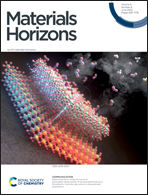Stretchable solvent-free ionic conductor with self-wrinkling microstructures for ultrasensitive strain sensor†
Abstract
Stretchable solvent-free ionic conductors with outstanding physicochemical stability are attractive in emerging sensing devices. However, existing ionic conductors struggle to keep high strain sensitivity with a gauge factor (GF) smaller than 4 at a strain range of up to 100%, which seriously affects the reliability of the signal output. Herein, we prepared a novel solvent-free ionic conductor, consisting of a hybrid cross-linked polymer network and mobile ions. Exquisite reticular wrinkling microstructures with ion channels were formed spontaneously by utilizing modulus mismatch in shrinkage during polymerization. The ion channels promote the ionic transport in the polymer, and the reticular wrinkling microstructures dramatically reinforce the mechanical stability and enhance energy dissipation. After being carefully optimized, the as-prepared ionic conductor demonstrated many unique advantages including perfect physicochemical stability, wide operating temperature range, the high ionic conductivity of 1.17 mS cm−1 at 15 °C and excellent sensitivity with GF as high as 7.03 at 100% strain. Moreover, benefiting from the abundant hydrogen bonds and ionic interactions in the polymer network, the ionic conductor also possesses self-healable and adhesion ability. The resulting devices can be used for quantitative evaluation of human joint motion and exhibit great potential in soft electronics or iontronics.



 Please wait while we load your content...
Please wait while we load your content...